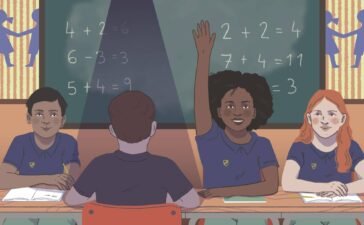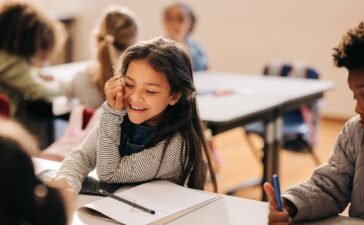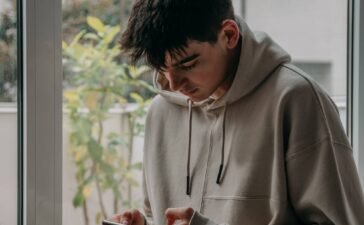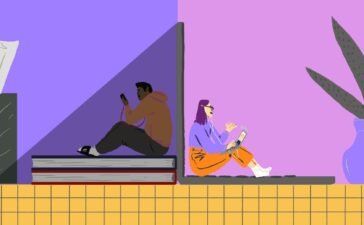Episode Transcript
This is a computer-generated transcript. While our team has reviewed it, there may be errors.
Ki Sung : Welcome to the MindShift Podcast where we explore the future of learning and how we raise our kids. I’m Ki Sung. This month marks 50 years since the fall of Saigon, the end of the Vietnam War. And while the Vietnamese-American community here has flourished and grown, their representation in children’s books is catching up with the population. In today’s episode, we’ll hear from children’s book illustrator Minnie Phan, who illustrated the book, Simone. The story of Simone is set in California and brings to life some of the decisions a young girl is forced to make when evacuating her home because of a wildfire. Minnie Phan illustrated the book, but the text of the story was written by Pulitzer Prize-winning author Viet Thanh Nguyen.
Ki Sung: Minnie Phan, welcome to Mind Shift. Tell us about your book, Simone, and what inspired you to tell this story.
Minnie Phan: Hi, it’s so great to be here. I’m thrilled. It’s an honor. And Simone actually came from 2020 during a very intense time for I think everyone across the globe where especially especially in the Bay Area where we had not just the pandemic but the wildfires as well. So as I’m processing and and going through the motions I was leaning into myself as an adult I was leading into what I’ve always which was drawing and painting and writing. And I thought, what are kids doing? And I had a feeling kids were doing the exact same thing. They were drawing and writing and recording, reflecting. And so I wrote a short book about wildfires and this experience of this little girl who is trying to understand the world through her sketchbook. I pitched it to my agent and she said, I love the art, but the story is somewhere, it’s not quite there yet. Do you wanna work with a writer? in, you know, I guess I’ve got guts because I suddenly said, I know a writer and I suggested, I suggested Viet Thanh Nguyen who I met 10 years ago and he’s one of my literary heroes and I was there at the launch of The Sympathizer before it won the Pulitzer and I followed his career for almost a decade over and I just always knew that one day I wanted to work with him. So when this opportunity came up, I said, try to ask Viet. And I remember before any editors or publishers or any contracts, anything happened, Viet got the email from his agent about my project and Viet said, call me. So I call him, I pitch him this wordless storybook, this word less storyboard. And, I swear in that moment, I thought, I bombed, I blew it, he’s never gonna work with me. And then 20 minutes later, I got an email and he said, Okay, let’s go.
Ki Sung: Congrats on landing such a big fish.
Minnie Phan: My family’s from a fishing village, so I’ve got it in my bones.
Ki Sung: Awesome.
Minnie Phan: So, I often pitch the book as a young girl facing intergenerational… experiences with climate change. But Viet often says, I think it’s more about a young girl and the power of art and how art is used to connect with herself and other people. Because the book is more than just about this terrifying fire that threatens her home. It’s about how she’s able to connect with other people who are going through similar experiences by saying, hey, draw with me, tell me your story. Let’s draw your house. What does it look like? Do you want to go home? What does your home look like?
Ki Sung: I do love that contrast maybe between the kids’ experience versus the adults because there is one page where adults are using big words that kids may have seen. But this is really about processing events that happen in kids’ lives that may be out of their control.
Minnie Phan: Absolutely, for sure. I mean, I’m thinking about, can I go into my favorite children’s book?
Ki Sung: Absolutely.
Minnie Phan: Okay. I’m think about when I was a kid, I actually did not read very much. My parents are like many Vietnamese immigrants, refugees from Vietnam, specifically central Vietnam. And I remember I didn’t really have very many avenues for for communication, connection, understanding, but there was one book that I remember so clearly. I’m gonna read the title. Alexander and the Terrible, Horrible, No Good, Very Bad Day. And I remember, so clearly, picking up this book and saying, this is how I feel on a really bad day. This is how feel. And it didn’t matter, really, what happened that day, but it was that I could connect and identify what was going on. And that was because of a picture book. You know, my parents and I… We didn’t have a very strong shared language. I moved a lot as a kid in the Bay Area. I was born in Stockton, but went to five elementary schools all over the Bay Area. So I didn’t have a lot of stable connections, but I always had books, drawing, writing, and sketchbooks.
Ki Sung: To be honest, this is inspiring to me because I think there are a lot of educators who do teach students who have struggles communicating with their parents, who maybe are the translator for their family, translating very important documents, who move from place to place, don’t ever really feel settled. So this is really great to hear your reflection on your personal experience and help other kids access that as well through this book.
Minnie Phan: Absolutely. Representation is vital to my work, of course, but really, I think the core of why I do what I do is to connect with my inner child, which I think all of us have within. And I think, the closer you are to your inner child the better you are able to make media and art for children, because you really understand the experience. Being a kid is both joyful and beautiful and exciting and fun, of cause, but I think adults underplay, underappreciate the deep. feelings that children have, the deep ability that children are capable of. Not many people go through growing up in a refugee immigrant family. It’s a lonely experience, and it’s scary. But I did it, and so many millions of other have. And I think that’s also why we need art in the Vietnamese diaspora, because it captures this experience that is truly unique and special. And I could go into my journey.
Ki Sung : Yeah, let’s hear it. I know you just got back from a big trip to Japan and Korea, is that right? And a few years ago you had also gone to Vietnam. Can you talk about your travels?
Minnie Phan: Okay, yeah, this is big, we’re gonna get into it. So, I mentioned I’ve moved a lot as a kid, five elementary schools. I actually ended up going to high school in Pleasanton and I struggled a lot in high school. I almost didn’t graduate, I had a terrible GPA and I was just in the wrong crowd. But my art teacher really saw something in me and he believed in me. Shout out to Mr. Doyle at Amateur Valley High, He’s phenomenal. changed my life. He really showed me what art could do and I found passion and meaning and direction and so I applied to art school my senior year and I got a full-ride scholarship to California College of the Arts. And I remember it broke my parents heart. They were so upset they couldn’t believe it even if it was a full- ride scholarship to a private art school. They felt that I was choosing hunger in a way where They did not choose hunger. It was forced upon them. My parents grew up in central Vietnam in a small village in a province called Quang Thi, which I’m so sorry to the Vietnamese people listening. I know my Vietnamese is not good, but that’s okay. But they’re from a small fishing village. And my mother had to drop out of school when she was in third grade. My father, when he was in fifth grade, because they were surviving a famine, war. They’ve lost loved ones. Hunger was not an option. It was a reality. And so when I chose art school, all they could see was she’s choosing a difficult life. But they did not understand at that moment that what I was choosing was to tell our stories, was to heal so many of the intergenerational wounds or at least attempt to heal through a chorus of artists’ voices, the wounds that the Vietnamese diaspora across the globe has. And it has been a beautiful journey. I think my life wouldn’t be what it is if I didn’t go to art school. When I was a junior at CCA, I won a scholarship that was no strings attached money. I could do anything, pay tuition, get art supplies. And I decided to go to Vietnam for the first time by myself. Three weeks, I had no idea what I was doing. I’d never been on a plane alone before and I’d ever been to a rural place, a developing country, I’ve never met so many family members. But I had to, I have to because my parents really just wanted to lift us up economically in a safe place where we didn’t have to worry about. disease, war, et cetera. But I wanted to know, who am I? Who are we? How do we get here? Why are we here? And there’s so many things that we did not learn in school, in high school, et cetera. So I had to really, I think I wanted to be brave and do hard things. And that experience changed my life. I was 21 and I met so many kind relatives. People were so sweet and I saw wealth inequality and poverty at a scale I’d never experienced before. But I also saw love and joy and affection in a way that only a village, a true village could provide. And also, The experience humanized my parents because my parents were so upset about my choice to go to art school. But when I went to Vietnam, I was staying at the home of my parents, my mother’s childhood home, and I suddenly could see, I could suddenly see her little kid feet running through the sand. And I remember this elder came to visit the house and she had lost her sight and she actually had raised my mother when my grandmother had died. And this woman, she lifts her hands and she touches my face and she goes, I know who this is. This is Tay’s daughter. I know her. And so then I suddenly had this opportunity to ask, what was my mother like when she was a girl? What was she like when was little? There were suddenly so many avenues and I needed that healing. And I think I could not make it through or be there at that place if I weren’t an artist, seeing the world through an artist’s lens. I was there to bear witness to the lives of the people around me and also my own life. It really changed me going back to Vietnam. I came back and I think I held a lot more forgiveness and understanding and love for my parents and my family best they could do.
Ki Sung: I know teenage years are hard for everybody, but when you’re able to look at the longer arc of a relationship, those moments of recovery, right, of healing can be so beneficial in the longer term. So I’m glad you had that experience. And the art that you make is also how people can recall and process their experiences. So you’re imprinting your message on to. kids and adults as well when they go through the hardship and think about how to recover from that.
Minnie Phan: Hmm. Yeah, it’s interesting. Actually, I think the going so thinking about the picture book space as specifically about diversity and representation. I Think the most successful books are the ones that capture The child experience or the experience of an individual in that moment I’ve noticed a few directions in the picturebook Community that’s about diversity or diverse picture books one is the writer healing a trauma, the really specific things that they wish they had seen when they were a kid. And they want this book to exist because it’s important. And it’s like, if this book exists now, my younger child self can have it. And I think there are also other books where it’s specifically about the experience of the kid. I also illustrated a book called The Yellow Aoi with Han Bui. And the Aoi, that’s… Al-Yai. Al-yai. OK. And that book was about another metaphor for intergenerational connection about a young girl who finds her mother’s al-yaj and dances in it and then tears it, and she feels so bad. But an essential part of that book is forgiveness. I think that’s part of the healing that I think kids want to hear, like it’s OK to make mistakes. It’s OK. And so I think those are the stories that I really, really connect with.
Ki Sung: Yeah, and breaking something of your parents or tearing something that is always terrifying as a kid. Definitely. Okay, so what books can you recommend that feature Vietnamese American characters?
Minnie Phan: Oh, there’s so many. I really love the book Wishes. I believe that one’s by Monty. And I also I love, I loved The Best We Could Do by Tee Bui. It’s been my North star. I actually met Tee when she was still working on it and I was there at the launch of her book and it’s just been so beautiful seeing the reception to her graphic novel. And also I feel like we’re in a I’m in a sance right now. I see creative power, cultural power, building in the Vietnamese community. And I love it, I love. And Viet talks about this often, narrative plentitude, for us to have many, many voices and to eventually go beyond the pain and trauma of war, which of course is vital and important and must be honored. But for us, to move forward as individuals and as a community, we have to see beyond the heartache, the pain and see the potential, the joy, the future. And so much of our future is in our young people who get to have so many opportunities that we and our parents didn’t get to have, but they get right this second. Any other books you want to recommend? Yeah. Oh, let’s see. There’s the Magic Fish, which is about coming out and being queer. There’s Family Style about food. Oh, there’s a great, really interesting book called My Vietnam, Your Vietnam by Christina Vo, or Vo. And it’s It’s told, this is actually maybe more of an adult book, but it’s her perspective of living in Vietnam and her father’s experience of living in Vietnam. So it’s both of their experiences living abroad and the book eventually converges in the center where they meet. It’s very interesting. It’s like a dual memoir. Oh, you know what? I wanna give a big shout out. I wanna to give a shout out UN, UNFAM, UNfam. So when I graduated art school, I was brand new to the field. I had no examples of Vietnamese people in the arts. And I was browsing spectator books in Oakland one day and I picked up this book and I just loved the art. It was watercolors. It was playful. It was cute. And it was just so good. I believe it was Vampirina Ballerina. but I picked it up and I suddenly saw the name and it was a Vietnamese name, the last name Pham. And it was such a beautiful, inspiring moment where I remember saying, if she can do it, I can do. And actually I had this beautiful full circle moment where I was on stage with her last year at the Viet Book Fest, presented by Vala. And I got to tell her the story and it was just beautiful that she was a trailblazer. She’s a Vietnamese American illustrator and writer making it happen. If my 18 year old self could see her and just know that even though my community has no idea what I’m pursuing, it is possible. I can be an artist. And I hope whoever’s listening to this, it really does not give up telling their story, making art, being creative. And if you see your little, if you your little making art and being creative, let that flourish. It’s gonna show up in so many different ways.
Ki Sung: Those are great recommendations. I hope that more kids and parents read those books. I hope they see themselves in the stories and also embody what gives them joy. And at every age, art is that, and it can unlock so many other experiences, much like what you have learned throughout your career. So thank you, Minnie Phan, for being here with us on Mind Shift.
Minnie Phan: Thank you so much.
Ki Sung: Minnie Phan is a children’s book illustrator who recently published Simone with Viet Thanh Nguyen, and she’s a writer and artist based in Oakland. We’ll bring you more ideas and innovations from experts in education and beyond. Hit follow on your favorite podcast app so you don’t miss a thing. The MindShift team includes me, Ki Sung, Nima Gobier, Marlena Jackson-Retondo, and Marnette Federis. Our editor is Chris Hamburg. Seth Samuel is our sound designer. Additional support from Jen Chien, Katie Springer, Maha Sanad, and Holly Kernan. MindShift is supported in part by the generosity of the William and Flora Hewlett Foundation and members of KQED. Thank you so much for listening.






